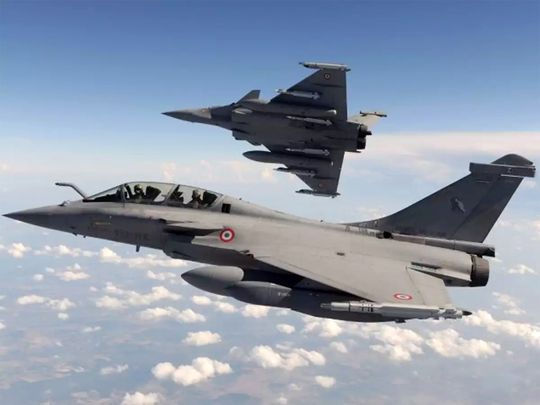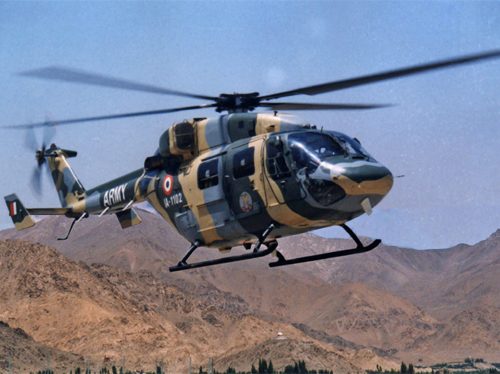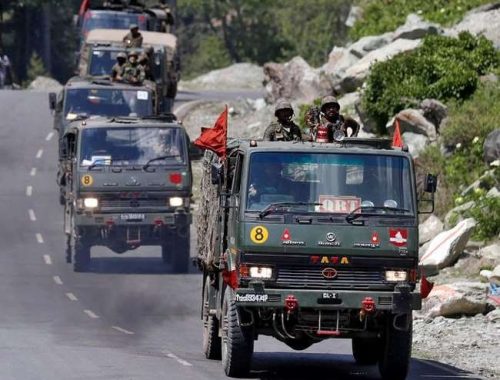The first batch of five Rafale jets took off from France on Monday and will be arriving in India on Wednesday, when the much-awaited fighter jets will officially be inducted and join the Indian Air Force fleet at the Ambala air base in Haryana.
The Rafale aircraft will cover a distance of nearly 7000 kms from France to India with air-to-air refuelling and a single stop en route in UAE. The Indian Air Force pilots and supporting personnel have been provided full training on aircraft and weapon systems by Dassault.
The Indian embassy in France said the event marked a “new milestone” in strong and growing India-France defence cooperation. The embassy also released a short video titled “Beauty and the Beast”, showcasing Rafale jets ready for take off.
Indian ambassador Jawed Ashraf was there to see off the Rafale aircraft. He also met the Indian pilots and congratulated them on becoming the first ones to fly the world’s most advanced and potent fighter aircraft and wished them success.
“These five Rafale jets are extremely swift, versatile and very deadly aircraft, they’re both beauty and beast. I would like to thank Dassault for delivering aircraft on time and French Government and French Air Force for all the support,” said ambassador Ashraf.
India ordered 36 Rafale jets from France in a deal worth Rs 59,000 crore in September 2016 as an emergency purchase to arrest the worrying slide in the IAF’s combat capabilities.
Acting on a special request by the IAF, France has accelerated the deliveries of Rafale fighters to India — five jets are coming instead of four that were originally planned to be delivered in the first batch.
France handed over to India its first Rafale fighter during a ceremony attended by defence minister Rajnath Singh and his French counterpart, Florence Parly, in Merignac on October 8 last year.
The delivery of all 36 aircraft will be completed by the end of 2021, said the Indian mission in France.
India’s Rafale Vs China’s J-20: Which is the Better Fighter Plane?
The French Dassault Rafale is about to be inducted into the Indian Air Force. It will be the IAF’s most advanced fighter aircraft. Across the LAC, it has to take on China’s Chengdu J-20. Here is a head-to-head comparision.The French Dassault Rafale is about to be inducted into the Indian Air Force. It will be the IAF’s most advanced fighter aircraft. Across the LAC, it has to take on China’s Chengdu J-20. Here is a head-to-head comparision.
The Indian Air Force will induct its first batch of Dassault Rafale fighter planes on 29 July, at the Ambala air force station. Following their induction into the 17th squadron, the Rafale will be one of the IAF’s most advanced aircraft in its fighter fleet.
In the context of the recent troop and fighter plane deployment along the Line of Actual Control (LAC), here is a comparison of the Rafale with its equivalent in the People’s Liberation Army Air Force (PLAAF).
PLAAF operates a range of fighter planes, including Sukhoi SU-27, SU-30MKK and SU-35S, Chengdu J-7 and Chengdu J-10. But since Rafale is one of the most technologically advanced aircraft of the IAF, it is only fair to compare it with the Chengdu J-20, China’s most advanced fighter aircraft.
The Dassault Rafale is a French twin-engine, canard delta wing, multi-role fighter aircraft and considered to be in the 4.5 generation category. The J-20 is a single-seat, twin-jet, all-weather, stealth, 5th generation fighter aircraft developed by China’s Chengdu Aerospace Corporation.
Here is a look at the specifications of the two fighter planes.
Radar systems are used to detect enemy aircraft or any other targets. China has not provided any official information on the radar used in the J-20. However, according to reports, this fighter plane uses an Active Electronically Scanned Array (AESA). The same radar system is used by the Rafale as well. AESA is considered one of the most advanced radar technologies in the world.
Defense Minister Rajnath Singh put some flowers as a ritual gesture on a Rafale jet fighter during an handover cermony at the Dassault Aviation plant in Merignac, near Bordeaux, southwestern France, on 8 October.
Defense Minister Rajnath Singh put some flowers as a ritual gesture on a Rafale jet fighter during an handover cermony at the Dassault Aviation plant in Merignac, near Bordeaux, southwestern France, on 8 October.(Photo: PTI)
Does that mean that they have equal capabilities? Not really. How the radar system is optimised using different avionics and technologies makes all the difference.
One of the key technological features on the Rafale is its electronic warfare suite – SPECTRA.
SPECTRA protects the aircraft against airborne and ground threats. Various methods of detection, jamming, decoying and a highly re-programmable system capable of analysing threats better, makes it extremely difficult to detect and shoot down a Rafale.
Reportedly, the Rafale’s radar and SPECTRA system make up around 30 percent of the plane’s cost.
On the other hand, the J-20’s AESA radar comes with a chin-mounted infrared/electro-optic search and track sensor. The Chinese also claim that a passive electro-optical detection system in the J-20 gives its pilot 360-degree coverage of the battlefield. We’re told that the plane is also capable of accessing real-time data from Chinese military satellites.
The Rafale’s stores management system is Mil-Std-1760 compliant, which provides for easy integration of customer-selected weapons.
With its 10-tonne empty weight, the RAFALE is fitted with 14 hard points (13 on the RAFALE M). Five of them are capable of drop tanks and heavy ordnance. Total external load capacity is more than nine tonnes (20,000 lbs.). Hence, RAFALE can lift the equivalent of its own empty weight in payloads.
“Buddy-buddy” refuelling missions can be carried out in portions of the airspace out of reach of dedicated and vulnerable tanker aircraft.
With its outstanding load-carrying capability and its advanced mission system, the RAFALE can carry out both air-to-ground strikes, as well as air-to-air attacks and interceptions during the same sortie.
It is capable of performing several actions at the same time, such as firing air-to-air missiles during a very low altitude penetration phase: a clear demonstration of the true “OMNIROLE” capability and outstanding survivability of the RAFALE.




